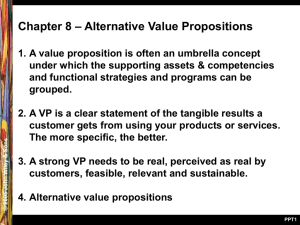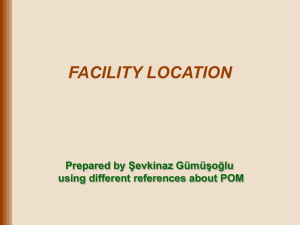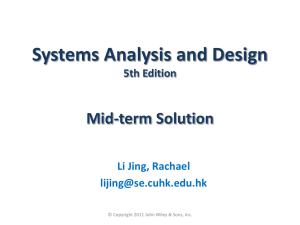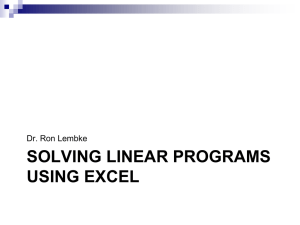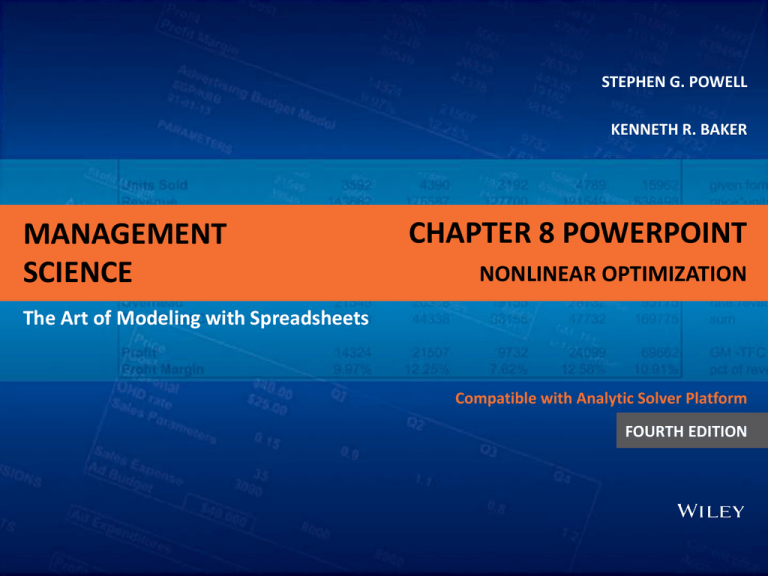
STEPHEN G. POWELL
KENNETH R. BAKER
MANAGEMENT
SCIENCE
CHAPTER 8 POWERPOINT
NONLINEAR OPTIMIZATION
The Art of Modeling with Spreadsheets
Compatible with Analytic Solver Platform
FOURTH EDITION
OPTIMIZATION
• Find the best set of decisions for a particular measure of
performance
• Includes:
– The goal of finding the best set
– The algorithms (procedures) to accomplish this goal
Chapter 8
Copyright © 2013 John Wiley & Sons, Inc.
2
EXCEL OPTIMIZATION SOFTWARE
• Solver
– Standard with Excel
• Analytic Solver Platform
– Comes with text – install off text CD
– More advanced than standard solver
– Is preferred tool throughout text
Chapter 8
Copyright © 2013 John Wiley & Sons, Inc.
3
DECISION VARIABLES
• Levers used to improve performance
• Want to find the best values for the variables
• Finding these best values can be challenging
– Need Solver’s sophisticated software
– Still relatively easy to construct models beyond Solver’s
capabilities
Chapter 8
Copyright © 2013 John Wiley & Sons, Inc.
4
SOLVER WINDOW
Chapter 8
Copyright © 2013 John Wiley & Sons, Inc.
5
FORMULATION
• Decision variables
– What must be decided? Be explicit with units
• Objective function
– What measure compares decision variables?
– Use only one measure (as a “yardstick”) – put in target cell
• Constraints
– What restrictions limit our choice of decision variables?
Chapter 8
Copyright © 2013 John Wiley & Sons, Inc.
6
CONSTRAINTS
• Left-hand-side (LHS)
– Usually a function
• Right-hand-side (RHS)
– Usually a number (i.e., a parameter)
• Three types of constraints
– LHS <= RHS
– LHS >= RHS
– LHS = RHS
Chapter 8
(less-than [LT] constraint)
(Greater than [GT] constraint)
(Equality [EQ] constraint)
Copyright © 2013 John Wiley & Sons, Inc.
7
TYPES OF CONSTRAINTS
• LT constraints (LHS<RHS)
– Capacities or ceilings
• GT constraints (LHS>RHS)
– Commitments or thresholds
• EQ constraints (LHS=RHS)
– Material balance
– Define related variables consistently
Chapter 8
Copyright © 2013 John Wiley & Sons, Inc.
8
LAYOUT
• Standard model template is advisable
• Enhances ability to communicate
– Provides common language
– Reinforces understanding how models shaped
• Improves ability to spot modeling errors
• Enables “scaling up” more easily
Chapter 8
Copyright © 2013 John Wiley & Sons, Inc.
9
LAYOUT
• Organize worksheet in modules
– Decision variables, objective function, constraints
•
•
•
•
Place decision variables in single row (or column)
Use color or border highlighting
Place objective in single highlighted cell
Arrange constraints for visual comparison of LHS and RHS
Chapter 8
Copyright © 2013 John Wiley & Sons, Inc.
10
SOLVER TIP: RANGES FOR DECISION VARIABLES
• Arrange worksheet with all decision variables in adjacent
cells
–
–
–
–
Chapter 8
Enables a single reference to their range
Makes data entry efficient
Reduces clutter in Solver interface
Makes task pane description easier to interpret
Copyright © 2013 John Wiley & Sons, Inc.
11
INTERPRETING RESULTS
• Optimal values of decision variables
– Best course of action for the model
• Optimal value of objective function
– Best level of performance possible
• Constraint outcomes
– Constraint is tight or binding if LHS=RHS in LT or GT
constraint
– Throughout optimization, generally only some constraints
are binding
Chapter 8
Copyright © 2013 John Wiley & Sons, Inc.
12
INTERPRETING RESULTS: OPTIMIZATION SOLUTION
• Tactical information
– Plan for decision variables
• Strategic information
– What factors could lead to better levels of performance?
– Binding constraints are economic factors that restrict the
value of the objective.
Chapter 8
Copyright © 2013 John Wiley & Sons, Inc.
13
MODEL CLASSIFICATION AND THE NONLINEAR SOLVER
• Linear optimization or linear programming
– Objective and all constraints are linear functions of the
decision variables
• Nonlinear optimization or nonlinear programming
– Either objective or a constraint (or both) are nonlinear
functions of the decision variables
• Techniques for solving linear models are more powerful
– Use wherever possible
Chapter 8
Copyright © 2013 John Wiley & Sons, Inc.
14
“HILL CLIMBING”
• Technique used by Solver for nonlinear optimization
• Called LSGRG (Large-Scale Generalized Reduced
Gradient) algorithm
• Hill climbing in a fog
– Try to follow steepest path going up
– After each step, or group of steps, again find steepest path
and follow it
– Stop if no path leads up
Chapter 8
Copyright © 2013 John Wiley & Sons, Inc.
15
LOCAL AND GLOBAL OPTIMUM
• The highest peak is the global optimum.
– What we want to find
• Any peak higher than all points around it is a local
optimum.
– What the LSGRG algorithm locates
– Except in special circumstances, there is no way to
guarantee that a local optimum is the global optimum.
– If multiple local optima, then which is found depends on
starting point for decision variables – may want to run
Solver starting from multiple points
Chapter 8
Copyright © 2013 John Wiley & Sons, Inc.
16
PROGRAMMING EXAMPLES
• Facility location
• Revenue maximization
– Maximize revenue in the presence of a demand curve
• Curve fitting
– Fit a function to observed data points
• Economic Order Quantity
– Trade-off ordering and carrying costs for inventory
Chapter 8
Copyright © 2013 John Wiley & Sons, Inc.
17
SOLVER TIP: SOLUTIONS FROM THE LSGRG ALGORITHM
• When the GRG algorithm concludes with the convergence message,
“Solver has converged to the current solution, all constraints are
satisfied”, the algorithm should be rerun from the stopping point.
• This message may then reappear, in which case Solver should be
rerun once more.
• Eventually, the algorithm should conclude with the optimality
message, “Solver found a solution, all constraints and optimality
conditions are satisfied”, which signifies that it has found a local
optimum.
• To help determine whether the local optimum is also a global
optimum, Solver should be restarted at a different set of decision
variables and rerun.
• If several widely differing starting solutions lead to the same local
optimum, that is some evidence that the local optimum is likely to
be a global optimum, but in general there is no way to know for
sure.
Chapter 8
Copyright © 2013 John Wiley & Sons, Inc.
18
SOLVER TIP: AVOID DISCONTINUOUS FUNCTIONS
• A number of functions familiar to experienced Excel
programmers should be avoided when using the
nonlinear solver.
• These include:
–
–
–
–
Logical functions (e.g., IF or AND)
Mathematical functions (e.g., ROUND or CEILING)
Lookup and reference functions (e.g., CHOOSE or VLOOKUP)
Statistical functions (e.g., RANK or COUNT).
• In general, avoid using any function that changes
discontinuously.
Chapter 8
Copyright © 2013 John Wiley & Sons, Inc.
19
SENSITIVITY ANALYSIS FOR NONLINEAR PROGRAMS
• Tests our initial assumptions to see what impact they
have on our conclusions.
• Analysis of one or two variables can lead to optimal
values of those variables.
– E.g., using the Parametric Sensitivity tool.
• Solver tool for larger numbers of variables and
constraints
Chapter 8
Copyright © 2013 John Wiley & Sons, Inc.
20
SOLVER TIP: WHAT KIND OF SENSITIVITY ANALYSIS?
• Easy to confuse parametric sensitivity with optimization
sensitivity, which answer different questions:
– Optimization sensitivity determines how the optimal
solution changes with a change in parameter.
– Parametric sensitivity answers how specific outputs change
with parameters.
• The Solver tool can answer questions about how specific
outputs change with a change in one or two parameters.
Chapter 8
Copyright © 2013 John Wiley & Sons, Inc.
21
THE PORTFOLIO OPTIMIZATION MODEL
• The performance of a portfolio of stocks is measured in
terms of return and risk.
• When we create a portfolio of stocks, our goals are
usually to maximize the mean return and to minimize the
risk.
• Both goals cannot be met simultaneously, but we can use
optimization to explore the trade-offs involved.
Chapter 8
Copyright © 2013 John Wiley & Sons, Inc.
22
*EXCEL MINI-LESSON: THE COVAR FUNCTION
• The COVAR function in Excel calculates the covariance
between two equal-sized sets of numbers representing
observations of two variables.
• The covariance measures the extent to which one
variable tends to rise or fall with increases and decreases
in the other variable.
– If the two variables rise and fall in unison, their covariance
is large and positive.
– If the two variables move in opposite directions, then their
covariance is negative.
– If the two variables move independently, then their
covariance is close to zero.
Chapter 8
Copyright © 2013 John Wiley & Sons, Inc.
23
SUMMARY
• Optimization: Answers “What values of the decision
variables lead to the best possible value of the
objective?”
• Excel Solver: Collection of optimization procedures
– Nonlinear Solver is Solver’s default choice
• Steps: 1) formulating, 2) solving, and 3) interpreting
optimization problems.
Chapter 8
Copyright © 2013 John Wiley & Sons, Inc.
24
SUMMARY
• These guidelines for model builders are the craft skills
typically exhibited by experts:
– Follow a standard form whenever possible.
– Enter cell references in the Solver windows; keep
numerical values in cells.
– Try out some feasible (and infeasible) possibilities as a way
of debugging the model and exploring the problem.
– Test intuition and suggest hypotheses before running
Solver.
Chapter 8
Copyright © 2013 John Wiley & Sons, Inc.
25
COPYRIGHT © 2013 JOHN WILEY & SONS, INC.
All rights reserved. Reproduction or translation of
this work beyond that permitted in section 117 of the 1976
United States Copyright Act without express permission of
the copyright owner is unlawful. Request for further
information should be addressed to the Permissions
Department, John Wiley & Sons, Inc. The purchaser may
make back-up copies for his/her own use only and not for
distribution or resale. The Publisher assumes no
responsibility for errors, omissions, or damages caused by
the use of these programs or from the use of the information
herein.
10 - 26




